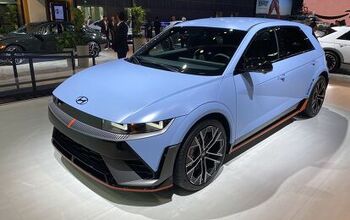Japan's Unorthodox Answer To the Power Outage: Holidays

If The Nikkei [sub] is informed correctly, and given the recent track record with these matters, that’s a big if, then workers in the Japanese auto and electronics industries will be compensated for the hardships they endured after the March 11 earthquake and tsunami: They will get two extra days off per week. According to today’s Nikkei story, the Japan Automobile Manufacturers Association proposed that manufacturing industries should alternate production holidays this summer as a way to conserve electricity amid a constrained supply.
“Automakers, for example, could halt production on Mondays and Tuesdays, with electronics firms taking Tuesdays and Wednesdays off, according to JAMA’s plan, which was presented at a briefing on energy-saving measures hosted by the Japan Business Federation, better known as Nippon Keidanren,” writes the Nikkei. “On each day, the shutdowns would extend industry-wide.” Honto?
When the Nikkei wrote last month about a similar plan involving the auto industry only, major Japanese automakers disclaimed any knowledge of such a plan. Pretty soon it became clear why: Such a power-sharing agreement would have been against Japan’s anti-monopoly laws. A relaxation of these laws has since been put on the agenda, but my contacts in the industry did not get excited. “Do you know how long it takes for such a law to go in effect in Japan?” was one of the more benign commentaries.
As far as the Nikkei goes, they are all keyed up about the idea: “JAMA ran a simulation that divided its 12 member companies into seven groups. The results showed that alternating production holidays would cut peak electricity consumption over 15%,” writes the Nikkei tonight. “Combined with a proposal to stagger summer vacations, the rotation plan would reduce usage by more than 20% in August, when member firms typically go on summer holiday all at once, the association said. JAMA intends to seek support for its proposal from other industries and come up with a more concrete plan next week.”
We’ll keep an eye on it. It’s 2 am in the morning in Japan as this is being typed, and even the most diehard Japanese salaryman is home by now and under the futon. I’ll try to get some answers next week. A lack of stable power is a huge problem that could throw back the Japanese industry for many months, or possibly years. From what we have heard in past discussions, there are no easy answers.
In the meantime, other power-saving ideas are making the rounds: Vending machines will serve less cold drinks. Consumers “ are rushing to buy fans instead of air conditioners.” Sales of energy-efficient home appliances are up. Stores are switching neon-lights over to LEDs. TTAC will be reporting live from Tokyo for most of next month for an eyewitness account. We will be required to save 25 percent power, so maybe only 3 stories per day instead of four.

Bertel Schmitt comes back to journalism after taking a 35 year break in advertising and marketing. He ran and owned advertising agencies in Duesseldorf, Germany, and New York City. Volkswagen A.G. was Bertel's most important corporate account. Schmitt's advertising and marketing career touched many corners of the industry with a special focus on automotive products and services. Since 2004, he lives in Japan and China with his wife <a href="http://www.tomokoandbertel.com"> Tomoko </a>. Bertel Schmitt is a founding board member of the <a href="http://www.offshoresuperseries.com"> Offshore Super Series </a>, an American offshore powerboat racing organization. He is co-owner of the racing team Typhoon.
More by Bertel Schmitt
Latest Car Reviews
Read moreLatest Product Reviews
Read moreRecent Comments
- Bd2 If I had time to watch other people driving, then I would go for LMP.
- Steve Biro There are 24 races on this year’s F1 schedule. And I guarantee you no more than two will be reasonably exciting, Meanwhile, F1’s reception for Andretti reveals the dark underbelly of the sport. I have followed F1 since the 1960s and, frankly, I am running out of interest. I’ll catch a race if it’s convenient but won’t bother DVRing them.
- YellowDuck Been watching since the 80s, seriously since the 90s once we had reliable TV coverage. I'm in Canada though. Hey, and don't forget that the Interlagos race is also in a convenient time zone, as is Mexico. So that's 5 races in the Americas. Absolutely love it, but it takes a bit more interest in the technical / strategic side of things to really appreciate it. It's not just going fast in circles until someone crashes into someone else, while drunk people watch. The US can be proud of what it has contributed - Austin is one of the best tracks on the calendar, Vegas turned out to be much better than anyone could have hoped, and even Miami - a real Indy car-style track - produced a good race this year.
- JMII I watch every F1 race, same with Indycar which is 100X better in terms of actual racing.
- Dale Quelle surprise.

































Comments
Join the conversation
So Bertel, a good time to go down to the beach for a little... "navel gazing"?
Hope that water isn't radio-active.